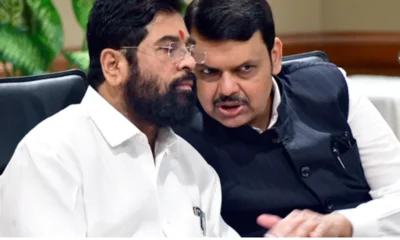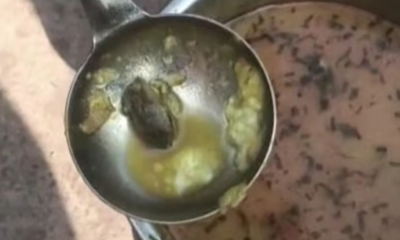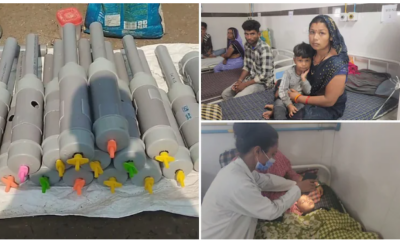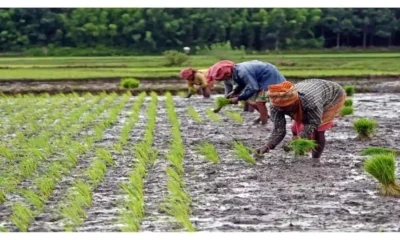[vc_row][vc_column][vc_column_text]The artisans’ colony at the crossing of National Highway 24 and NOIDA Road in east Delhi is super-busy these days. Youth, women and tiny tots as young as five years have their hands sparkling with glitter as they decorate Ganesha idols two days before the essentially West Indian festival of Ganesh Chaturthi commences.
This is an added workload—and earning opportunity—for the artisans’ colony. Hitherto, they would have been preparing for Durga Pooja, with the festival season culminating in Dussehra, but now, amid the presence of more and more Indians from all corners of the country coming into the capital, the cultural calendar just got busier, and Ganesh Chaturthi, Chhath, Vishwakarma Pooja and Saraswati Pooja have also become grand occasions. The artisans’ colony can thus be seen sculpting images to mark all these occasions.
Ganesh Chaturthi has also acquired an added political dimension, with a belligerent and vocal Hindutva brigade seeking to appropriate all cultural expression. The celebration of this festival, which began in Mumbai in the early 20th century and was subsequently conducted by the Marathi community in adjoining western Madhya Pradesh, was confined to a handful of families in Delhi till about two decades ago. That was evident from the scant numbers which assembled for immersion on the 10th day along the banks of Yamuna on the ITO flyover. Now, look at the strength of devotees, who, like kanwarias and Durga Pooja pandal-hoppers, throng the tents where Ganesha idols are on display, book the statue weeks in advance, escort their deity in trucks in the early hours of Ganesh Chaturthi to the accompaniment of blaring loudspeakers and drums, and think nothing of disrupting traffic on a busy Delhi-UP highway.
But it all translates into brisk business for the artisans, most of whom are migrants from Rajasthan and Gujarat. From procuring the dyes, clay, plaster of Paris and tinsel, to paying workers (Rs 1,000 a month), providing them chai-pani and meals, looking after logistics like where they will stay, to catering to client specifications, protecting the idols from the elements and traffic, pandering to police tantrums, and finishing work before D-Day, all of this is excruciating to accomplish in this heat.
Then there is the worry of escalating costs, thanks to GST. Sukh Lal, who is in his forties, says that the input cost, which would have been between Rs 30,000 and Rs 35,000— this includes dyes that come from Pan near Pune, has gone up to Rs 70,000 to Rs 80,000. Each package of dye is used to make 25 idols. Add to that the labour. Lal, for instance, employs two persons—and the earnings per statue come out to Rs 4,000 to Rs 6,000.
Sukh Lal doesn’t think employing small children is problematic. He says the children of the family are taught the art since an early age. “If they can’t get education, they should at least learn something useful. They should become sculptors—artists,” he says. Children in large numbers are seen at work here.
However, everyone is not as forthcoming as Sukh Lal. Many are reluctant to share innocuous information like how much time it takes to make each idol, where the raw material comes from, what is the cost of each idol.
One idol caught our attention—it was a king or courtierly figure, whose headgear evoked Islamic style. We asked for his identity, and the sculptor replied: “This is Akbar”. How does one explain Akbar at the durbar of Ganesha? We were directed to see the shop owner-and-contractor with our query, but he disappeared at the sight of the media.
Photos by Bhavana Gaur
Text by Meha Mathur

Bahubali Returns

Far from the Shattering Sun

Meritricious Detail

Vajrapaani

Ganga-Jamuni Tehzeeb

God of Small Things

Vighnaraaj in Green and Gold

Bahubali Redux

My Friend Ganesha

No Child’s Play This

Ganesha and Garuda

Damodara Loves His Crisps

God Bless

Art in Progress
[/vc_column_text][/vc_column][/vc_row][vc_row][vc_column][vc_column_text]
[/vc_column_text][/vc_column][/vc_row]


 Latest world news23 hours ago
Latest world news23 hours ago
 India News7 hours ago
India News7 hours ago
 India News6 hours ago
India News6 hours ago
 India News6 hours ago
India News6 hours ago
 India News5 hours ago
India News5 hours ago
 India News3 hours ago
India News3 hours ago
















































































